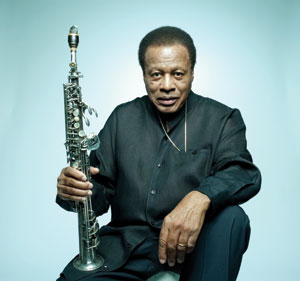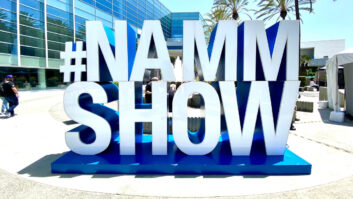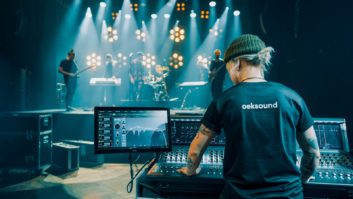
Wayne Shorter
The incomparable tenor and soprano saxophonist Wayne Shorter may be turning 80 this August, but he’s not slowing down and his music is every bit as vital as ever. His latest release is the live Without a Net, featuring the amazing acoustic group he’s fronted since 2000—Danilo Perez (piano), John Patitucci (bass) and Brian Blade (drums). The nine-song collection serves up a mixture of sonorous melodies, dissonant excursions and complex pieces that visit many styles; all Shorter compositions except “Flying Down to Rio,” from the Astaire-Rogers film.
Without a Net was recorded to iZ RADAR by Shorter’s “sound traffic controller” since 1995, Rob Griffin, on a seven-show tour of Europe in the fall of 2011. “I was very fortunate to have a group endorsement with DPA Microphones,” Griffin says, “so all the mics on there, except on ‘Pegasus’ with the Imani Winds [from the Disney Concert Hall in 2008], are DPAs, and I couldn’t be happier.”
He used four mics around Blade’s kit—a wide cardioid 4028 on the kick, 4021 cardioids as overheads “from his ear position, angled down to get his dynamics and tone from his perspective,” and a tiny 4061 omni “taped to the side of the rack tom as a center-kit mic.” Piano was three 4021s—low, mid and hi inside. Bass was a 4021 on a clip between the bridge and tailpiece, as well as a David Gage piezo pickup and Rolf Spuler WooDi. Shorter takes a 4028, which Griffin says, “has no leakage problems, and being wide cardioid, has much less proximity effect and an even tone.”
“I don’t go for a room sound,” he says. “I want it to sound as if the audience is right in front of the band on a stool, six feet from Wayne. I like the humanity that comes forth when you’re close, the little quirks of energy.”
Extended Q&A With Engineer Rob Griffin on the Recording of the Wayne Shorter Quartet’s Without a Net Live Album

Rob Griffin
On recording a band over time (Griffin previously cut Footprints Live and Beyond the Sound Barrier in concert with the Quartet): You start to understand each musician and the way they play. Because I feel as if I’m the matrix between everything they’re trying to accomplish and the audience. To connect the musicians’ hearts and intentions to each heart in the audience, it has to pass through me and this instrument we call a console. I take that responsibility very seriously. Over time, it’s allowed me to make better and wiser microphone choices and placement choices and understand how those choices can affect the music and the performance. My job is to reveal everything and add nothing.
The plan for Without a Net: The original intention for this record was to release a single concert from the seven we were doing in Europe. After the first show in London, I went backstage to Wayne as soon as the show was over and I said, “Hey, I’ve got the title for the new CD-Live in London,” because it was really killing; it was so good. What’s funny is we didn’t end up using anything from that show! The shows kept getting better. But it’s a mix, with seven different venues, which means seven different pianos, seven different drum kits. John Patitucci carries his own bass, thank goodness.
A bit about the drum mics: On Brian [Blade] I was concerned, with the DPA endorsement, what we would do with the bass drum, because I had been using a Royer R122 ribbon I really liked. But the 4028 wide cardioid ended up being fantastic. The isolation is super, and I’m able to pick up a wider area of the head and get a much better tonality on the bass drum. And those mics will really take the level. I mike Brian with 4021 cardioid overheads from his ear position. It hit me some years ago that Brian has spent his whole life getting his dynamics and tone from his perspective–his ears are his microphones–so I put those two as close to his ears as I can without being intrusive, and angled down.
On the 4061 rack tom mic: I’m picking up the whole kit with the other mics, but when Brian starts to use his hands on the skin of the snare drum I can grab that, or if I need more rack or snare. Brian also tends to throw various thicknesses of towels on his snare and he plays with that and then throws it off, and it’s good for that. So it’s mostly for the really soft stuff, and it’s a nice center image if I want it.

Without a Net album cover
More on the piano: In addition to the three [4021s] on the piano [played by Danilo Perez] , I use two Schertler pickups–they’re from Switzerland. They’re about the size of a silver dollar and I mount them under the piano. And here’s something I learned years ago–I use a stethoscope to place them. They’re moving coil diaphragms. So I use a mid-hi pickup as a security blanket in case we’re playing outside for 20,000 people or if Brian’s ripping it up [and noise bleeding into the piano mics]. So I constantly mix. And I also have one for the low end, only when he digs down into the lowest octave of the piano.
Mics pre’s and cables: I use True System Precision 8 mic pre’s, which gives me eight discrete channels in a single rack space. They have excellent transient response and the accuracy is great. It’s also fantastic that they have dual outputs–both DB25 and TRS, so I shoot a cable out of there using the TRS outs to go to the live sound system and DB25 directly to the iZ RADAR AD’s. I also use and highly recommend Vovox Sonorus cables. Jurg Vogt is making the best cables I’ve ever heard–they’re shockingly good. We have the RADAR near Gabriel Fonseca’s monitor position to keep those cable runs short.
On the track from L.A.’s Disney Concert Hall, featuring the Imani Winds: The Imani Winds had toured with them several years before in Europe, but we didn’t record that stuff multitrack, and we also had this one-off about a year-and-a-half later [2008] at Disney. We went in and had one little rehearsal soundcheck and Wayne brought in this piece called “Pegasus,” and man, they just kicked ass on it. Normally, I use a little Korg DSD recorder and we [record] every show, but Disney would not let me do it. So I went back to them and I said, “Can’t you just archive this somehow so it exists, please?” And what they did was record on a Tascam [stereo] CD recorder at 16-bit.
They lost the recording for several years and then ended up finding it and they got it to Wayne. You would be shocked if you heard it. It was so ambient and there was virtually no piano, so I went crazy when I hit the studio with it and started tearing it apart with sum and difference, my frequency sections… Usually I don’t mix in the box at all, but for that one I took it over to Jeff Ciampa’s Orange Studio and he was using Sound Performance Lab’s De-Verb, which is something like a transient designer, and we were using it to decrease room ambience. Then I was doing everything I possibly could to bring things forward in the mix. I ended up on the console with maybe eight different channels–stereo channels of various amounts of De-Verb, tracking with maybe -2 dB of the room, -3, -4, and I brought stuff out like a maniac.
More on the post-production work in his home studio: On all this stuff I rerecord everything. I track it live, I come home to my studio and I go at it in RADAR, using Vovox cables, and I go to an auto router, a CM Labs 64, which is like an automated patchbay–a 32-in, 32-out digitally controlled analog patchbay. I have two of those, so all of my analog gear in my studio is connected to this thing, and I can route anything to anywhere and then immediately change to another setup instantly. They’re awesome.
So I take everything out [of the RADAR] and rerecord everything two to four tracks at a time, and I do crazy stuff. One thing I do is phase-align every microphone to the best of my ability. Say I’ve got an overhead and a bass drum. I’ll turn off one speaker, pan two items into one speaker and use that control until it feels like one thing, not two things. Phase aligning is so incredible because you’re getting an entirely different sonic effect and frequency effect than you can possibly get with equalization. Thank God for Jonathan Little at Little Labs, who created the IBPs-in-between phase boxes.
I also use a Cranesong Ibis EQ–I love that–and the Cranesong STC-8 stereo compressor. Another amazing thing from Little Labs I used on the record is called the VOG–the “Voice of God” analog bass resonance tool. That thing is awesome.
The only reverb I use is the Sony S777 convolution reverb, which is the most realistic thing I’ve ever heard. I use Adam S2.5A [nearfield] speakers, a big Tannoy 15-inch subwoofer and a Sony DMX R100 digital console for fader automation and panning.
I want to mention, too, that I mastered with Mark Wilder at Battery Studios in New York. He did a wonderful job for us. He has great ears and so much experience mastering jazz classics and reissues.







